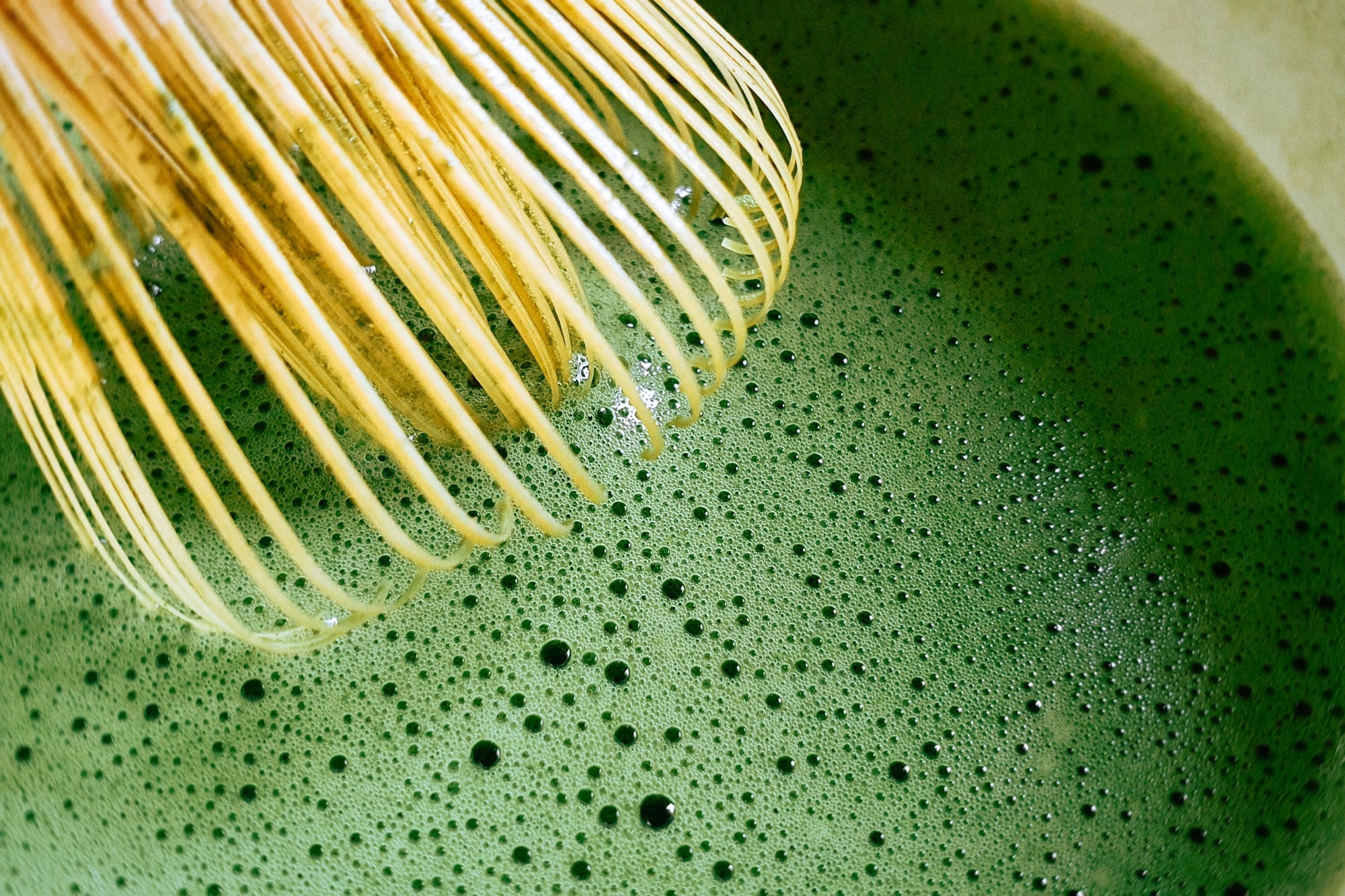
It’s green, it’s frothy, and it’s served both hot and cold. Matcha is the new “it” ingredient in everything from lattes to smoothies to protein shakes. But this begs the question: What does this green stuff taste like?
Hop on board as we take a trip around the world to learn about its origins and flavors, as well as techniques used to prepare matcha. We’ll start off in China, then travel to Japan, and circle back home to discover how matcha is now consumed in the Western world.

Matcha-Do About History: Where Does Matcha Come From?
Matcha originated in China during the 7th and 10th centuries. A Japanese Buddhist monk living in China is credited with bringing green tea plants from China to Japan when he returned home. These tea plants, which Zen Buddhist monks used to prepare a powdered form of green tea, were considered the origin of the highest-quality tea available at the time.
Meanwhile, back in China, a new method of growing green tea was developed called Tencha. This involved planting the trees in the shade, which helped preserve the health benefits of the tea leaves. This method of growing green tea leaves is still in practice today and is used to increase levels of l-theanine, caffeine, chlorophyll, and catechins.
During the times of the Shogun clans who ruled Japan, only limited quantities of the tea were produced, giving it significance as a cultural status symbol. Matcha soon became a staple in the Japanese tea ceremony, a spiritual ceremony in which members of the Japanese elite would prepare the tea with special instruments and meditate on its taste and their environment.
Today, the majority of matcha is produced in Japan, where it is highly regarded as part of the tea ceremony. China also produces some matcha primarily for export, but it is considered inferior to Japanese matcha and typically used in cafe-style drinks and even in culinary applications.
What Does Matcha Taste Like?
Just like coffee, dry red wine, or a robust, spicy whiskey, matcha can be an acquired taste. It has a unique flavor the Japanese refer to as “umami,” which means the essence of deliciousness. It’s earthy, full, and has a vegetal taste and grassy flavor that is slightly akin to a wheatgrass shot — but slightly more bitter and less grassy.
While some people notice an aftertaste, the flavor and echo of matcha can vary heavily depending on the quality of the type of matcha used. Think of it like comparing instant coffee to your favorite, ethically sourced arabica beans.
How Does Matcha Compare to Green Tea?
Matcha is a concentrated form of green tea. Regular green tea is made by brewing green tea leaves in water, but the leaves themselves aren’t consumed.
Matcha, on the other hand, is made by grounding the leaves into a powder, mixing the powder in hot water, and consuming it whole. As the shade-grown tea leaves used for matcha are protected from the sun’s leaching effects, they are richer in nutrients, including chlorophyll.
Naturally, matcha flavor will be stronger and earthier than green tea, but it can also harbor more health benefits.
The Different Grades of Matcha and Their Tastes
Matcha is available in different grades, and taste will vary based on the grade of matcha you purchase.

Ceremonial-Grade Matcha
Considered the matcha gold standard, ceremonial-grade matcha is made from young, delicate leaves at the very top of the tea bush harvested during the first harvest season (April-May). These leaves are bright green and bursting with chlorophyll. Ceremonial-grade matcha is considered premium matcha and is set apart by its vibrant green color and sweet taste.

Culinary Grade Matcha
Matcha that is harvested from older tea leaves during the second (June-July) and third (September-October) harvests is called culinary-grade matcha. These leaves, which have been exposed to more sunlight, are usually slightly lighter in color than ceremonial-grade matcha leaves.
The differences between the grades of matcha can affect their flavor. Ceremonial-grade matcha is considered a high-quality matcha tea and is made specifically for drinking only.
Culinary-grade matcha isn’t low-grade tea, but it does tend to be more bitter than ceremonial-grade matcha, which means it usually isn’t the best for drinking plain. Instead, it’s commonly used in smoothies and other recipes to lend the flavor of matcha.
The Art and Science Behind the Taste of Matcha
You don’t have to be a tea master to understand the differences between the different flavors in matcha. We’ll give you the breakdown so you can impress your friends the next time you meet for tea.

Quality of the Leaves
The first thing that affects the way matcha tastes is the green tea leaves’ quality. Ceremonial leaves are young, tender, and loaded with nutrients like chlorophyll. They’ve been grown exclusively in the shade so that the sun cannot leach out their color, nutrients or other compounds. These leaves will have a richer, sweeter taste than older leaves used in culinary matcha.
The flavor of this tea will be richer, have a slightly sweet taste due to their higher concentration of L-theanine, and is infused with the unique umami flavor.
Plant-Compounds
The compounds inside the matcha leaf play a role in how the tea tastes.
- Chlorophyll and l-theanine: This compound contributes to matcha’s bright, emerald green hue, as well as its nutritional profile.
- L-theanine: This amino acid, found in higher concentrations in ceremonial grade matcha, imparts a slight natural sweetness.
- Catechins. These antioxidant compounds are responsible for the slightly bitter taste of the tea.
Together, these three compounds produce “umami,” which is known to be savory, rich, and bold, and defines matcha’s flavor profile. These compounds also come with health benefits, but we’ll touch on that in a minute.
How To Make and Drink Matcha
You don’t have to be a barista (or even visit one) to enjoy a cup of matcha. Here, we’ll give you a step-by-step guide on how to make matcha using only hot water, a matcha whisk (known as a chasen), and a high-quality matcha powder.
Some pro tips for both of the preparations below:
- Filtered water will help improve the taste and help you avoid any metallic taste you might experience from your local tap water.
- Heat your water to 176F/80C (or allow the water to cool just below boiling).

Traditional preparation with ceremonial grade matcha
- Place a half teaspoon (about 1 gram) of good matcha powder into your cup. For the smoothest drink, use a strainer to sift the powder into the cup so that it is incredibly fine.
- Add two ounces (¼ cup) of hot water to your cup.
- Using your chasen or a frother, vigorously whisk the matcha green tea powder back and forth until you’ve created a thick, well-blended paste, about 15 seconds.
- Optional: if desired, add additional hot water to lighten the flavor, according to your taste preference (1-4 oz).
Matcha latte with ceremonial grade or culinary grade matcha
- Heat 8 oz (1 cup) of milk of your choice (we love oat or coconut!), or leave it cold if making an iced latte.
- Separately, using a chasen or a frother, mix ½ to 1 teaspoons (more will yield a stronger matcha taste) of matcha powder and two ounces (¼ cup) warm water to create a matcha “shot” or concentrate.
- Pour heated milk into a mug. Add sweetener to the milk (if desired), froth milk, and then top off with your matcha shot.
You can find the best matcha tools available on platforms like Amazon or private matcha retailers, and you can get the ultimate rechargeable handheld frother from JOYÀ.

Creative Ways To Enjoy Matcha
If the thought of bright green powdered tea in boiling water isn’t as appealing to you as it might be to others, that’s okay. You can still enjoy matcha, and its unique flavor, in other creative ways:
- Incorporate matcha into smoothies and protein shakes for breakfast or pre-workout and post-workout snacks.
- Create a matcha ice cream that will seriously elevate your ice cream sandwich.
- Consider sweetening up your matcha. Using monk fruit, stevia, honey, or coconut sugar can increase the sweetness of matcha flavor.
- Create your own intentional matcha ceremony. Japanese tea ceremonies celebrate hospitality, respect, and mindfulness. You can borrow from these traditions by adding matcha to your mindfulness practices.
Health Benefits of Drinking Matcha
While you’re getting acquainted with this fine powder, you should know there are many health benefits that matcha offers.
Boost Your Antioxidant Arsenal
Antioxidants help protect our cells against oxidative stress caused by free radical damage. Our bodies produce these free radicals as a natural byproduct of metabolism, as well as when we are exposed to external stressors like UV light, cigarette smoke, and pollution.
Loading up on antioxidants helps protect our bodies against these free radicals, and drinking matcha is one way to load up on antioxidants and help fight off free radicals.
Focus and Calm: L-Theanine's Matcha Magic
Most people you know who consume matcha probably do so because they got burned with caffeine. You know the drill. You wake up tired, so you drink a caffeinated beverage. You suffer through the jitters (still slightly foggy-headed), only to experience an energy crash by mid-afternoon. And then you go for another cup.
The combination of l-theanine and caffeine in matcha supports cognitive function and promotes a “calm and focused” effect on the brain. L-theanine calms the nervous system and helps balance the stimulation from caffeine, which is why people experience a cleaner burning energy level when they consume matcha compared to other caffeinated beverages.
A Heart-Healthy Choice in Your Cup
We’re all looking for ways to support our heart health, and since the WHO just took red wine off the table, we can turn to matcha. Matcha helps support healthy heart function, and early research suggests that it may be able to support better blood flow. While more research is needed to confirm these findings, this is very promising.

Get Whisked Away With Marvelous Matcha
There are many ways you can enjoy matcha, and heading over to JOYÀ is a good place to start. Our Focus Matcha Superblend powder contains certified organic ceremonial-grade matcha blended with complementary herbs and adaptogens to help boost the wellness quotient of our powder.
You can also find some great matcha recipes on our blog to help you discover new and intentional ways to make your daily matcha happen. Enjoy your matcha and the benefits that come with it.
